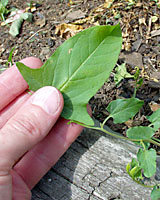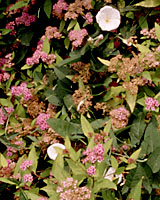Terry L. Ettinger Horticulture Consulting Services
Meeting The Needs Of Today With A Vision For The Future
Question of the Week
Controlling Vine-like Weeds
 Q. We installed new landscape plantings throughout our property three years ago. Now, many of the
low-growing shrubs are being overrun by a fast-growing vine. The vine has both large and small arrow-shaped leaves and
flowers that look like morning glories. Weíve tried to pull the vines up, but they keep coming back! What is this stuff and
how can we get rid of it?
Q. We installed new landscape plantings throughout our property three years ago. Now, many of the
low-growing shrubs are being overrun by a fast-growing vine. The vine has both large and small arrow-shaped leaves and
flowers that look like morning glories. Weíve tried to pull the vines up, but they keep coming back! What is this stuff and
how can we get rid of it?
A. Unfortunately, youíve just provided an excellent description of hedge and/or field bindweed. The leaves of both of
these fast-growing, perennial vines are arrow-shaped with several distinguishing characteristics. Hedge bindweed
(Calystegia sepium) leaves are three to four inches long and
 have a pointed tip
(above, at right). Meanwhile, field
bindweed (Convolvulus arvensis) leaves are no more than two inches long and have rounded tips,
at left.
have a pointed tip
(above, at right). Meanwhile, field
bindweed (Convolvulus arvensis) leaves are no more than two inches long and have rounded tips,
at left.
Both plants are well-adapted for long-term survival which means they can be extremely difficult to control in landscape settings.
Itís been reported, for example, that a single field bindweed plant six months after germination produced 197 vertical roots, each at least 4 feet long for a total of 788 feet while growing in a large container. The plant also produced 34 horizontal underground roots averaging four feet in length from the main tap root, giving the plant 136 additional feet of root growth. Shoot buds along the 34 horizontal roots produced 141 new shoots capable of establishing themselves as new plants.
And, if this plantís ability to produce new plants from its root system isnít discouraging enough, studies have shown that its seed can survive in the soil for more than 25 years before germinating!
Bring the bindweed under control in your landscape is going to require a three-pronged approach.
First, donít try to pull the plants out of the ground. Their root systems can extend ten to twenty feet into the soil! In fact, by trying to pull the plants out of the ground youíre actually encouraging the shoot buds along the roots to break, creating even more new shoot to come to the soil surface!
 Your best option is to identify where the vines are coming out of the ground,
such as among the spirea in the picture at right. Become familiar with
these locations and cut the vines off right at the ground at least once each week for rest of the summer. Cutting the vines
will limit their ability to produce carbohydrates (plant food) through the process of photosynthesis without encouraging
more shoots to arise from buds along the roots.
Your best option is to identify where the vines are coming out of the ground,
such as among the spirea in the picture at right. Become familiar with
these locations and cut the vines off right at the ground at least once each week for rest of the summer. Cutting the vines
will limit their ability to produce carbohydrates (plant food) through the process of photosynthesis without encouraging
more shoots to arise from buds along the roots.
In early September let the vines to grow for a couple of weeks. Then, using a glove-in-glove technique, carefully wipe the stems with the non-selective herbicide Roundup. In late summer and early autumn plants translocate this herbicide most efficiently from the leaves into the root system, resulting in better control of target weeds.
Thereís no question but that this process can be very tedious and time-consuming. Unfortunately, because these vines are so invasive and adapted for long-term survival, it may be the only option you have for bring them under control!